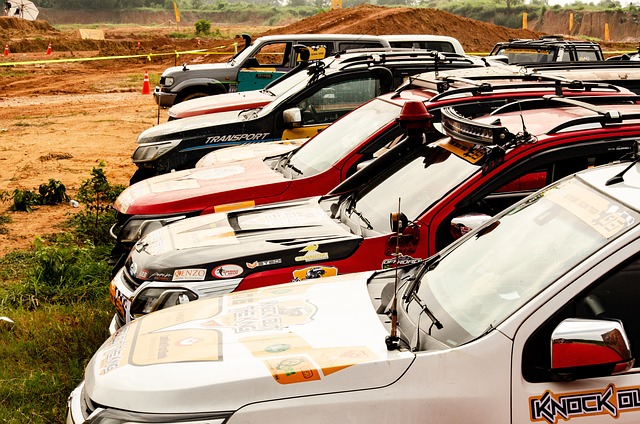McAllen 4×4 repairs focus on quick disconnects (QDCs) for performance and durability. Regular maintenance prevents system malfunctions caused by poor practices or low-quality parts. A methodical approach involves inspection, tool gathering, part replacement, and careful reassembly. Choosing reputable, compatible parts ensures reliability and longevity. Simple visual checks and protection from elements further safeguard QDCs. Regular attention to these details enhances McAllen 4×4 performance in demanding terrains.
McAllen vehicles are known for their robust 4×4 systems, but even the most reliable mechanisms can face quick disconnects. Understanding these sudden malfunctions is key to ensuring smooth drives in all terrains. This article delves into the intricacies of McAllen 4×4 repairs, uncovering common causes and offering step-by-step guides. We also provide insights on choosing quality replacement parts and preventive measures to avoid future issues. By mastering these aspects, McAllen drivers can confidently navigate any trail while minimizing 4×4 system interruptions.
- Understanding Quick Disconnects in McAllen Vehicles
- Common Causes of 4×4 System Malfunctions
- Steps for Efficient McAllen 4×4 Repair
- Choosing the Right Replacement Parts
- Preventive Measures for Future Quick Disconnect Issues
Understanding Quick Disconnects in McAllen Vehicles

In the world of McAllen 4×4 repair, understanding quick disconnects is paramount for ensuring optimal vehicle performance and durability. Quick disconnects, as the name suggests, are mechanisms designed to facilitate swift and easy removal or attachment of components, particularly in rugged vehicles meant for off-road adventures. These innovative parts play a crucial role in McAllen’s renowned 4x4s by allowing for rapid changes during trailside repairs or gear shifts.
By employing quick disconnects, drivers can effortlessly swap out damaged or specialized equipment without the need for extensive tools or time-consuming processes. This feature is especially valuable when navigating challenging terrains where efficiency and adaptability are key to a safe and successful journey. Thus, for McAllen vehicle owners, recognizing and maintaining these critical components through regular McAllen 4×4 repair services is an essential part of embracing the adventurous spirit that defines their off-road experiences.
Common Causes of 4×4 System Malfunctions

In McAllen 4×4 repair shops, one of the most common issues encountered is system malfunctions, often stemming from several interrelated factors. Poor maintenance practices are a leading cause, with many drivers overlooking regular checks and services that are vital for keeping 4×4 systems in top condition. Neglected fluid levels, worn-out components, and inadequate lubrication can all contribute to performance problems and, eventually, complete system failures.
Another significant cause is the use of incompatible or low-quality parts during repairs or upgrades. Using subpar components can lead to ongoing mechanical issues, as these parts may not withstand the rigorous demands placed on 4×4 systems. Ensuring that all replacement parts are genuine, high-quality, and compatible with your specific vehicle model is essential for maintaining optimal performance and preventing future malfunctions.
Steps for Efficient McAllen 4×4 Repair

When it comes to McAllen 4×4 repair, a systematic approach can make all the difference in getting your vehicle back on the road swiftly and effectively. Start by thoroughly inspecting the 4×4 system, identifying any damaged or worn components. This includes checking the transfer case, differentials, driveline, and driveshafts for signs of wear, cracks, or leaks.
Next, gather all the necessary tools and replacement parts. For McAllen 4×4 repair, you’ll likely need jack stands, socket sets, wrenches, and possibly new seals, gaskets, or bearings. Once prepared, carefully remove any components that are damaged or require replacement. Ensure proper alignment and adjustments during reassembly to guarantee smooth operation and maximize the lifespan of your 4×4 system.
Choosing the Right Replacement Parts

When it comes to McAllen 4×4 repair, selecting the right replacement parts is paramount for ensuring your vehicle’s reliability and performance. Not all components are created equal, so it’s essential to choose parts that meet or exceed the original manufacturer’s standards. Look for reputable brands known for their quality and durability.
At the heart of a successful 4×4 repair lies the integration of compatible parts. This includes not just engine components but also suspension systems, brakes, and electrical fittings. Ensuring these replacements are designed to work seamlessly with your vehicle’s existing hardware minimizes potential compatibility issues down the line.
Preventive Measures for Future Quick Disconnect Issues

To prevent future quick disconnect (QDC) issues in your McAllen 4×4, regular maintenance is key. Check and replace any worn-out or damaged connectors promptly to avoid unexpected failures during off-road adventures. A simple visual inspection can reveal loose connections or signs of corrosion, addressing these early can save you from costly repairs and ensure your vehicle’s reliability in demanding terrains.
Additionally, keeping an eye on the wiring harness for any cracks or exposure can help. Protecting the harness with protective covers or shielding can prevent physical damage. Moreover, adhering to manufacturer recommendations for fluid and temperature levels ensures optimal performance and longevity of QDCs, especially in extreme McAllen conditions.
Quick disconnects are essential components in McAllen 4×4 systems, ensuring smooth operation and robust performance. By understanding common causes of malfunctions and following efficient repair steps, vehicle owners can extend the lifespan of their McAllen 4×4 systems. Choosing the right replacement parts is crucial, while implementing preventive measures will further mitigate future quick disconnect issues. For a seamless McAllen 4×4 repair experience, prioritizing regular maintenance and utilizing reliable components is key.
